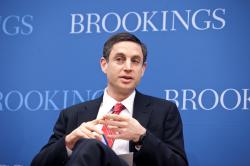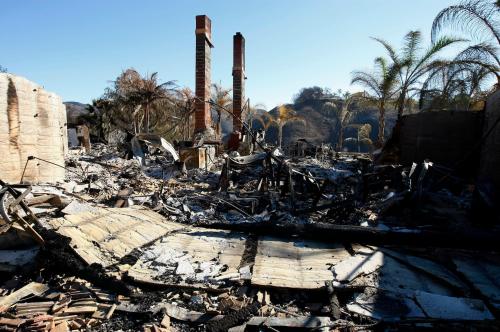The paper summarized here is part of the Fall 2021 edition of the Brookings Papers on Economic Activity (BPEA), the leading conference series and journal in economics for timely, cutting-edge research about real-world policy issues. The conference draft of the paper was presented on September 9, 2021 at the Fall 2021 BPEA conference. The final version was published in the Fall 2021 edition by Brookings Institution Press on June 7, 2022. The published paper, discussion comments and general discussion documentation can be accessed on the left side of this page under “Downloads”. Data and programs can be retrieved here. Read all papers published in this edition here.
The U.S. government should update its approach to estimating an important metric underlying a wide range of federal climate policies—from power plant emissions rules to vehicle fuel economy standards, suggests a paper discussed at the Brookings Papers on Economic Activity (BPEA) conference on September 9.
The paper—The social cost of carbon: Advances in long-term probabilistic projections of population, GDP, emissions, and discount rates—examines a variety of models, estimates, and accounting that can help to build a better—and more accurate—social cost of carbon. The social cost of carbon is an estimate of the economic costs, or damages, of emitting one additional ton of carbon dioxide into the atmosphere, and thus the benefits of reducing emissions. The estimate informs billions of dollars of policy and investment decisions in the United States and abroad.
The paper’s authors are Kevin Rennert, Brian C. Prest, William A. Pizer, Richard G. Newell, and Roger Cooke of Resources for the Future, a non-profit research institution; David Anthoff, Cora Kingdon, and Lisa Rennels of the University of California-Berkeley; Adrian E. Raftery and Hana Ševčíková of the University of Washington; and Frank Errickson of Princeton University.
“The social cost of carbon is a vitally important metric for informing the climate policy of numerous entities, including most notably its role in guiding climate regulations issued by the U.S. federal government,” the authors write. “… It is critical that its calculation is supported by the best available science, including an explicit incorporation of uncertainty.”
To this end, the authors explore the challenges of—and potential solutions to—generating estimates that reflect the range of future socioeconomic projections. The paper presents an updated approach that reflects the latest understanding of population growth, per capita economic growth, projected emissions, and the earth’s climate, while also supporting calculations over the very long time-horizon of greenhouse gases emitted to the atmosphere.
The authors incorporate uncertainty in a manner that addresses previous limitations of the estimates and provide an economic discounting approach that reflects the intergenerational timescale of climate change.
“If you want to know what the damages from climate change are going to be, you have to understand the range of how many people could be on the planet, what the future economy could look like, and what that means for future greenhouse gas emissions,” Rennert said in an interview with The Brookings Institution.
The paper implements key recommendations from the National Academies of Sciences, Engineering, and Medicine that are guiding the efforts of the Interagency Working Group on the Social Cost of Carbon, an Obama-era body re-established by executive order on President Biden’s first day in office. The interagency working group currently uses an interim social cost of carbon of $51 and is expected to announce an updated value for this critical estimate in a January 2022 report. New research grappling with uncertainty around climate change finds that the social cost of carbon likely is higher than previously estimated, especially if appropriate weight is given to future impacts.
Acknowledgments
David Skidmore authored the summary language for this paper.
Citations
Rennert, Kevin, Brian C. Prest, William A. Pizer, Richard G. Newell, David Anthoff, Cora Kingdon, Lisa Rennels, Roger Cook, Adrian E. Raftery, Hana Ševčíková, and Frank Errickson. 2021. “The Social Cost of Carbon: Advances in Long-term Probabilistic Projections of Population, GDP, Emissions, and Discount Rates.” Brookings Papers on Economic Activity, Fall. 223-275.
Greenstone, Michael. 2021. “Comment on ‘The Social Cost of Carbon: Advances in Long-term Probabilistic Projections of Population, GDP, Emissions, and Discount Rates’.” Brookings Papers on Economic Activity, Fall. 276-294.
Reguant, Mar. 2021. “Comment on ‘The Social Cost of Carbon: Advances in Long-term Probabilistic Projections of Population, GDP, Emissions, and Discount Rates’.” Brookings Papers on Economic Activity, Fall. 295-302.
Conflict of Interest disclosure
This paper draws on several years of work by the Social Cost of Carbon (SCC) Initiative at Resources for the Future (RFF), an initiative funded by private individual and foundation donors. Raftery’s work was supported by NIH/NICHD grant R01 HD-070936. Other than the aforementioned, the authors did not receive financial support from any firm or person for this article or from any firm or person with a financial or political interest in this article. They are currently not an officer, director, or board member of any organization with an interest in this article.
hIstory of bpea
The Brookings Institution is committed to quality, independence, and impact.
We are supported by a diverse array of funders. In line with our values and policies, each Brookings publication represents the sole views of its author(s).
















